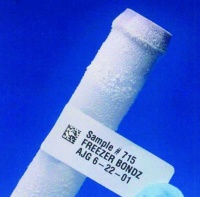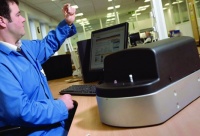
Accurately labelling vials containing antibodies is crucial to Cambridge-based antibody producer Abcam’s business, but until recently it was a time-consuming process that was performed manually.
To speed up operations and eliminate any possibility for labelling errors, Abcam’s production team wanted to develop a system that would automatically apply a label to each plastic vial of product.
Compared to the task of producing research-grade antibodies for use in academic and commercial institutions throughout the world, creating such a system might not seem all that challenging. However, when the engineering team at Cambridge Design Partnership was approached by Abcam to assist in the development of an automated system that could perform the task, it found that the process of making labels stick to such vials was far from straightforward.
First, the system had to read a small barcode on the bottom of each of the vials, then cross check the barcode data with product information on the database of a personal computer. It then had to apply a human-readable label with that information on it to each tiny plastic tube.
Reading the barcode from each vial was simply a case of deploying a camera at the base of the unit into to which each vial was placed. Printing the label was a straightforward enough task too – the engineers used an off-the-shelf printer from US label maker Brady. A more difficult engineering task was to attach the labels directly onto the vials once they had been printed.
The labels had to withstand freezing temperatures as low as -190°C and could potentially be applied to frozen vials. Engineers led by Dr Jez Clements, project leader at Cambridge Design Partnership, first had to find a material thin enough to meet the requirements, while avoiding jamming Abcam’s automated tube storage and retrieval systems.

After closely examining the reasons that the labels the company had used previously were not sticking to the vials in a consistent fashion, the engineers found some thinner label stock that they bought from Brady.
However, as effective as the so-called Freezerbond stock was, it presented the design team with its own problem – at just 70 microns thick, it was so flimsy that it proved very difficult to handle. The challenge then was how to apply it automatically. To achieve this, Clements and his team invented a way of presenting the labels to the vials and peeling the labels off their backing material so they could be wrapped around the tubes.
Cambridge Design Partnership director Mike Beadman said that the solution lay in the design of a V-shaped aperture through which the labels were passed to ensure that they remained rigid as they passed out of the system. After the labels emerge from the aperture, they are pulled downwards over the aperture’s sharp edge. As a result, the backing paper is removed from the labels, which are projected forwards and affixed to the sample.
’The upshot is that we have a very reliable labelling system that is scaleable – it could work for tiny labels as well as big ones. We have already demonstrated that the system can be used to label bigger containers often used for blood products as well as the smaller vials,’ he said.
Since the launch of the system, Beadman’s company has garnered a lot of interest from other high-throughput diagnostic laboratories faced with the problem of reliably labelling vials.
The engineers are also developing handheld versions of the product as the result of a direct request from the NHS. According to Beadman, such units could be used at a patient’s bedside where tubes of bodily fluids could be immediately labelled, eliminating any error that might be introduced in the process of manually handling the vials in a hospital environment.
The key facts to take away from this article
» An automatic labelling system is set to speed up operations at Abcam
» Engineers had to find a material thin enough to meet requirements
» The labels pass through a V-shaped aperture to ensure they remain rigid
» The system is scaleable and can, therefore, work for small and large labels




Red Bull makes hydrogen fuel cell play with AVL
Many a true word spoken in jest. "<i><b>Surely EVs are the best solution for motor sports</b></i>?" Naturally, two electric motors demonstrably...